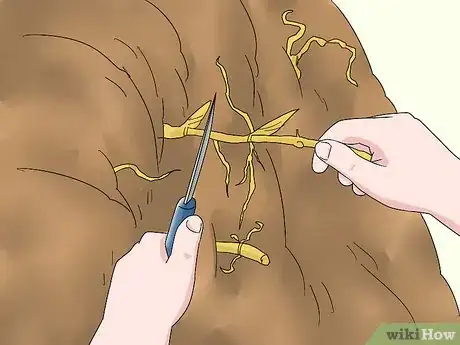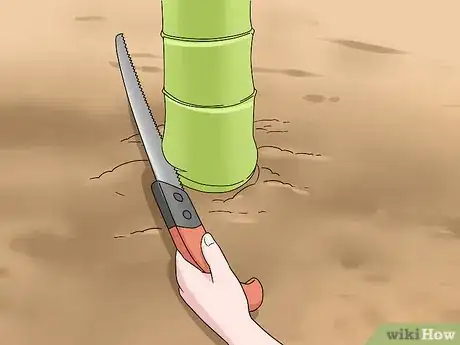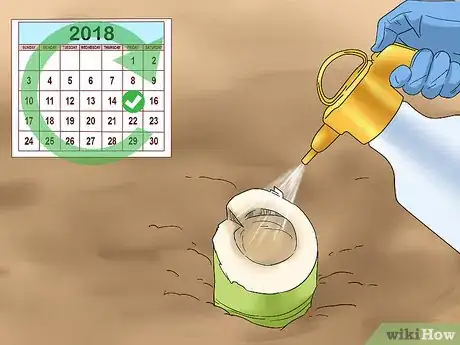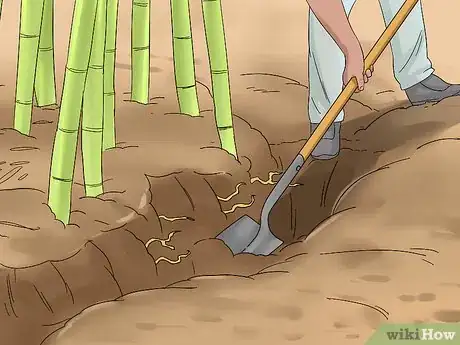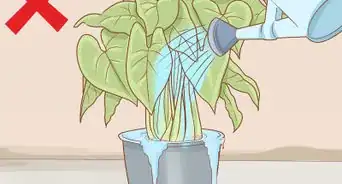This article was co-authored by Lauren Kurtz. Lauren Kurtz is a Naturalist and Horticultural Specialist. Lauren has worked for Aurora, Colorado managing the Water-Wise Garden at Aurora Municipal Center for the Water Conservation Department. She earned a BA in Environmental and Sustainability Studies from Western Michigan University in 2014.
There are 10 references cited in this article, which can be found at the bottom of the page.
wikiHow marks an article as reader-approved once it receives enough positive feedback. In this case, 92% of readers who voted found the article helpful, earning it our reader-approved status.
This article has been viewed 307,991 times.
If you want to protect other plants on your property from encroaching bamboo, or want to keep bamboo from invading your neighbor's yard, it’s important that you control where it spreads. Bamboo has thick underground roots called rhizomes, which must be severed to contain its spread. After severing the rhizomes, you can install plastic root barriers to prevent future rhizomes from growing. If you don't want the bamboo at all, you can remove it manually or use special herbicides to kill it.
Steps
Adding Rhizome Barriers to Surrounding Soil
-
1Dig a trench around the bamboo. Dig a trench that is 28 inches (71 cm) deep. The trench should be at least 2 feet (61 cm) away from the bamboo shoot. Once the trench is dug, you should be able to locate the bamboo rhizomes growing horizontally under the ground. The rhizomes will look like the main stalk of bamboo growing out of the ground.[1]
- Dig a couple of inches (cm) deeper if you don’t find any rhizomes.
-
2Sever and remove the rhizomes to control the direction of growth. If you don’t want the bamboo spreading any further at all, you’ll need to sever and remove all the rhizomes 2 feet (0.61 m) away from the main stalk. Cut through all the rhizomes in two places with a pointed shovel and remove the separated sections.[2]
- If you’d like to contain the bamboo to just a specific part of the yard, sever the rhizomes growing outside of the desired bamboo area.
- You can also try using a saw to cut thicker bamboo shoots and rhizomes. However, you'll have to dig out the soil all the way around the rhizome in order to get clear access to it with the saw.
Advertisement -
3Place a plastic root barrier in the trench. You can purchase a plastic root barrier specifically made for bamboo online or at a home and gardening store. Unroll the plastic root barrier and place it in the trench, so that it completely blocks off the rhizomes. [3]
- The root barrier must be installed at least 28 inches (71 cm) deep to prevent new rhizome growth.[4]
-
4Fill the trench back in with soil. Filling in the space between the trench walls and the root barrier will hold the barrier in place and make it less noticeable.[5]
- If you want to hide the barrier completely, cut the top of the barrier with gardening shears so that it runs flush with the ground. Cover the top of the barrier with soil and pat it down.
-
5Monitor the rhizomes and continue to cut them as they grow. The rhizomes will continue growing out as the bamboo grows. If you want to prevent new stalks from coming up in a specific area, you’ll need to sever and remove all the rhizomes underground in that area.
- Running bamboo rhizomes can grow 3–5 feet (0.91–1.52 m) per year and must be cut at least twice annually to control.
- Clumping bamboo rhizomes are less invasive than running bamboo and will only grow 1–3 feet (0.30–0.91 m) per year. This type of bamboo should be cut annually.[6]
-
6Hire professionals if the spread is too aggressive. If you've let the bamboo spread, it may be difficult to remove all of it yourself. If you can’t sever the rhizomes because they are too thick, call a professional landscaper with the tools to do it.[7]
- Call local landscaping companies and ask them if they have the equipment to cut larger bamboo rhizomes.
Killing Bamboo with Herbicides
-
1Purchase an herbicide with glyphosate. Glyphosate is a chemical herbicide that will eradicate an entire stalk of bamboo and the rhizomes growing underground. Search online or at a home and gardening store for a weed killer with glyphosate as an active ingredient.[8]
- Herbicides that contain glyphosate will kill any plants that come in direct contact with the herbicide. This is because it is a non-selective herbicide.
- Popular brands of herbicide that contain glyphosate include Roundup Pro Herbicide, Tiger Brand Quick Kill Concentrate, and Ace Concentrate Weed & Grass Killer.
-
2Cut the bamboo down to the ground. Use a manual or electric saw and cut down the bamboo near its base, so that it runs flush with the ground. If you are cutting down a very tall bamboo plant, cut down the top of the plant first, then make another cut towards the base of the bamboo.[9]
- Late winter is the best time to cut the bamboo down.
-
3Apply the herbicide to the bamboo stump. Wait till the bamboo shows new growth. Applying the herbicide to the new growth will kill the bamboo stalk and the rhizomes under the ground. Sprinkle or spray the herbicide onto the top of the bamboo stump.[10]
- Wear rubber gloves, long sleeves, long pants, close toed shoes, and protective eyewear when handling the herbicide.
- Diluting the herbicide with water may weaken it and makes it ineffective.
- Always read the instructions before using herbicides. There are specific moisture and temperature requirements to keep in mind when using these types of products.
- Do not apply this herbicide in or near bodies of water or you may kill surrounding wildlife.
-
4Repeat the process once a month until the bamboo dies. It may take up to 4 applications of the herbicide to fully eradicate the bamboo. Continue to cut down new growth and apply the herbicide through the spring and summer.[11]
Removing Bamboo Manually
-
1Cut the bamboo stalk to ground level. Use a pruner or saw to cut the bamboo down to ground level. Cutting down the main stalks of the bamboo will weaken it, but won't kill it completely.[12]
-
2Dig around the bamboo and sever the rhizomes. Dig a hole around the stalks of bamboo and sever the underground roots or rhizomes from the main stalk with a pointed shovel. The rhizomes will look like the main bamboo stalk, but will be growing underground. Severing and removing these rhizomes will prevent the bamboo from spreading underground.[13]
-
3Remove any existing rhizomes leading from the stalks. If you want to completely eradicate the bamboo, you'll have to follow the length of the rhizomes underground and remove them completely. This will stem new bamboo growth.[14]
- Clumping bamboo's roots are clumped closely together, which make them easier to remove.
- Running bamboo will grow underground and can spread at a much quicker rate.
-
4Mow over emerging bamboo stalks. Bamboo can be mowed occasionally without killing it, but constant mowing over a long period of time will weaken it enough to prevent future growth. Continue to mow over new growth until the bamboo stops growing.[15]
- If new stalks come out of the ground, it means that you haven't fully removed the rhizomes.
Community Q&A
-
QuestionIf bamboo is planted in large galvanized tubs, will that prevent spreading while allowing the bamboo to grow in height?
 GEttingerCommunity AnswerYes, this should prevent the rhizomes from growing outward but shouldn't inhibit vertical growth.
GEttingerCommunity AnswerYes, this should prevent the rhizomes from growing outward but shouldn't inhibit vertical growth. -
QuestionHow do I destroy bamboo without cutting it?
 NinoxTop AnswererYou can unearth the bamboo. You can also use herbicide on young spouts or stump remover on roots.
NinoxTop AnswererYou can unearth the bamboo. You can also use herbicide on young spouts or stump remover on roots. -
QuestionCan I use bamboo as a barrier or wall in a small area?
 Community AnswerMyan emperors used it to block out tigers on their Thai estates while travelling when congress was in recess for millennia...so yeah, I would think so.
Community AnswerMyan emperors used it to block out tigers on their Thai estates while travelling when congress was in recess for millennia...so yeah, I would think so.
Things You’ll Need
Adding Rhizome Barriers to Surrounding Soil
- Pointed shovel
- Tape measure
- Plastic root barrier
Killing Bamboo with Herbicides
- Herbicide with glyphosate
- Rubber gloves
- Manual or power saw
Removing Bamboo Manually
- Pruner or saw
- Lawn mower
References
- ↑ http://www.bamboogarden.com/barrier%20installation.htm#Open%20sided%20barrier
- ↑ http://www.bamboobotanicals.ca/html/bamboo-care/controlling-bamboo-spread.html
- ↑ https://youtu.be/w0iHAlNqYlw?t=1m46s
- ↑ http://www.bamboogarden.com/barrier%20installation.htm#Open%20sided%20barrier
- ↑ https://youtu.be/8pJ3JxAaK_U?t=3m28s
- ↑ http://www.bamboogarden.com/FAQ%20general.htm
- ↑ http://hgic.clemson.edu/factsheet/bamboo-control/
- ↑ http://hgic.clemson.edu/factsheet/bamboo-control/
- ↑ https://www.rhs.org.uk/advice/profile?PID=210
- ↑ http://hgic.clemson.edu/factsheet/bamboo-control/
- ↑ http://edis.ifas.ufl.edu/ag266
- ↑ http://www.bamboobotanicals.ca/html/bamboo-care/bamboo-removal-eradication.html
- ↑ https://www.rhs.org.uk/advice/profile?PID=210
- ↑ http://www.bamboobotanicals.ca/html/bamboo-care/bamboo-removal-eradication.html
- ↑ http://www.missouribotanicalgarden.org/gardens-gardening/your-garden/help-for-the-home-gardener/advice-tips-resources/pests-and-problems/weeds/bamboo.aspx
About This Article
To stop the spread of bamboo, cut the stalks to ground level to weaken them. Then, dig around the stalks and sever the roots underground with a pointed shovel, which will prevent the bamboo from spreading underground. If you catch the stalks early enough, you can also mow over them frequently, which will eventually weaken the bamboo so much that it won’t grow. You can also confine bamboo to a specific area by digging a trench 28 inches deep, which is deeper than all bamboo roots. Once the trench is complete, use a shovel to sever the roots, which you’ll see growing horizontally. After you’ve severed all roots, put a plastic root barrier in the trench, which you can buy from a gardening store, and fill it back in. For tips from our Gardening co-author on how to stop the spread of bamboo with herbicides, keep reading!




